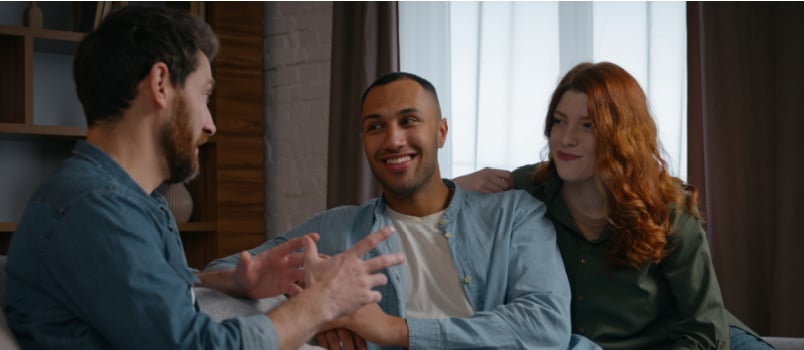7 Myths About Closed Triad Relationships Debunked

Unlock Daily 30-Sec Tips for a Happier Relationship
👉 Subscribe FREEKey Takeaways
Marriage.com AI Quick Summary
A lot of people are curious about what it’s really like to love and connect as a trio, yet the idea often comes with assumptions that can feel a little heavy.
Maybe you’ve heard a few stories that made you wonder… or you’ve bumped into opinions that sounded confident but didn’t quite sit right. Relationships can be tender, complicated, joyful; they grow in ways that don’t always fit the usual mold.
And when three people choose a closed triad relationship, it’s easy for outsiders to fill in the blanks with guesses rather than understanding the reality.
So instead of relying on the loudest voices, it helps to look closer at what truly shapes connection, care, and commitment—because so much of it may be gentler than you think.
What is a closed triad relationship?
A closed triad relationship is a committed partnership between three people who agree to be romantically and emotionally exclusive with one another. Think of it as a small, intentional circle where everyone is choosing connection, trust, and clarity.
Instead of dating outside the trio, all energy stays within the relationship; this creates a sense of stability and shared purpose. Some people find comfort in the closeness it offers, while others simply appreciate how naturally their bond formed.
A study compared relationship quality and perceived partner commitment in 29 polyamorous and 30 monogamous participants. Using the RAS and Investment Model Scale, results showed a significant difference in relationship quality between the groups, despite the hypothesis predicting no notable differences.
And sure, it can look different from the relationships we’re used to… but closeness, care, and commitment still guide it every day.
7 common myths about closed triad relationships debunked
A lot of people hear about triads and immediately imagine drama, imbalance, or chaos… but most of those ideas come from assumptions rather than lived experience.
Closed triad relationships can be tender, grounded, and surprisingly ordinary; they just grow in a shape some people aren’t used to. Below are 7 common myths that often show up, along with what really happens beneath the surface of a committed trio.
1. Closed triads are just a phase
Some assume triads are temporary or something people try on a whim. In reality, many trios build their relationship thoughtfully, taking time to understand each person’s needs and hopes. Commitment develops through shared experiences, steady communication, and genuine affection.
A relationship isn’t less serious simply because it involves three people. Many triads plan for the future, blend routines, and create long-term stability. When care is mutual, a triad can last just as long as any other partnership.
-
Why does this myth persist?
People often view anything outside monogamy as experimental or unstable, so they assume triads lack seriousness, even without hearing real experiences.
Here’s what closed triad relationships actually look like:
- Setting shared goals and checking in about expectations.
- Making decisions together instead of rushing into anything.
- Talking openly about long-term plans or commitments.
- Respecting each partner’s pace as the relationship grows.
- Building routines that help the trio feel grounded and steady.
2. Someone always ends up feeling left out
People often imagine constant jealousy or uneven attention, but healthy triads work intentionally to keep everyone included and involved. This might mean checking in regularly, noticing small shifts in mood, or adjusting plans so all partners feel valued.
Emotional balance takes effort, yet it’s entirely possible. Many trios cultivate a rhythm where everyone has space to speak, rest, and reconnect. And when misunderstandings happen—as they do in any relationship—they’re handled with care rather than fear.
-
Why does this myth persist?
Many assume three people can’t share emotional space equally, so they picture a third wheel scenario instead of a genuine connection and active care.
Here’s what closed triad relationships actually look like:
- Planning activities that involve all partners intentionally.
- Making time for one-on-one connections when needed.
- Checking in about emotional needs without judgment.
- Encouraging each partner to express concerns early.
- Shifting habits when someone feels overlooked.
3. Closed triads are less stable than couples
Stability doesn’t depend on the number of partners; it depends on communication, trust, and emotional consistency. Some triads actually feel more grounded because responsibility is shared among three, not two.
Research examined how personality, attachment, and relationship factors interact to influence relationship stability in 162 partnered participants. Findings showed attachment directly affected personality, relationship factors, and stability, while personality directly predicted stability. Relationship factors did not directly impact stability, nor did they mediate the influence of personality.
There’s room for different perspectives, skills, and forms of support. Of course, any relationship can wobble, but more people don’t automatically mean more conflict. When everyone is committed to growth, a triad can feel steady, warm, and deeply secure.
-
Why does this myth persist?
People equate “more partners” with “more chaos,” so they assume triads are fragile simply because they don’t fit traditional relationship models.
Here’s what closed triad relationships actually look like:
- Sharing emotional and practical responsibilities among all partners.
- Creating communication habits that keep stability strong.
- Practicing transparency during stressful or uncertain times.
- Supporting one partner when another feels overwhelmed.
- Working together to maintain a sense of calm and consistency.
4. Triads are only about sex
This myth pops up frequently, but it oversimplifies the real emotional connection found in many triads. While intimacy is part of the relationship, it isn’t the sole focus. Triads develop shared routines, inside jokes, long talks, and meaningful support systems.
Love grows through daily moments, not just physical ones. Many people in triads describe the relationship as a blend of friendship, romance, and comfort, which resembles any other committed bond.
-
Why does this myth persist?
The media often highlights sexual aspects of non-traditional relationships, leaving people unaware of the emotional depth and everyday tenderness found in real triads.
Here’s what closed triad relationships actually look like:
- Sharing hobbies, routines, and meaningful downtime.
- Showing affection in simple ways—touch, words, presence.
- Supporting one another during hard days or life changes.
- Building traditions and rituals as a trio.
- Developing emotional intimacy separate from physical intimacy.
5. Jealousy makes triads impossible
Jealousy can happen in any relationship, but it doesn’t automatically ruin a triad. What matters is how the partners respond to it—gently, honestly, and without blame. Many trios use jealousy as a signal to slow down and talk about underlying feelings.
This encourages a deeper connection rather than conflict. With time, reassurance, and patience, partners often feel more secure. Emotional growth becomes an integral part of the relationship, rather than something to fear.
-
Why does this myth persist?
People assume jealousy is uncontrollable, so they believe any relationship with more than two people must be constantly tense or competitive.
Here’s what closed triad relationships actually look like:
- Naming jealousy calmly instead of hiding it.
- Offering reassurance when someone feels insecure.
- Pausing to check in before emotions escalate.
- Exploring what triggers jealousy with curiosity.
- Treating jealousy as a moment for growth, not blame.
6. All three people must be equally attracted
Some believe every connection inside the trio has to match perfectly, but attraction rarely works in such neat lines. Partners might feel closer to one person at certain moments, then shift naturally over time. What matters most is openness, respect, and a willingness to communicate changes.
Triads often navigate attraction with care, giving each bond space to develop at its own pace. Harmony doesn’t require perfect symmetry; it just requires understanding.
-
Why does this myth persist?
People expect relationships to follow balanced, predictable patterns, so it’s hard for them to accept that attraction can ebb and flow without causing harm.
Here’s what closed triad relationships actually look like:
- Letting each bond develop at its natural rhythm.
- Talking openly about emotional closeness without pressure.
- Creating space for different types of connection.
- Supporting shifting needs without fear.
- Prioritizing honesty over forced equality.
Watch this TED Talk for a thoughtful look at how polyamory can create authentic love, community, and meaningful connection, as Dr. David Pascale Hague explores the benefits and challenges of open relationships:
7. Closed triads can’t last long-term
Many people assume triads fall apart quickly, yet plenty remain strong for years. Long-term success comes from shared values, emotional responsibility, and steady effort—just like any relationship. Partners grow together, adapt to life changes, and build a sense of home.
A triad’s longevity isn’t defined by outsiders’ expectations; it’s shaped by everyday choices and quiet moments of care. With commitment and kindness, long-term stability is absolutely possible.
-
Why does this myth persist?
Society rarely showcases long-lasting triads, so people assume they don’t exist, overlooking real examples of stable, loving, long-term trio commitments.
Here’s what closed triad relationships actually look like:
- Revisiting long-term goals together regularly.
- Supporting each partner’s individual and shared growth and development.
- Creating routines that nurture emotional closeness over time.
- Handling conflict with patience and steady communication.
- Choosing one another consistently, even during challenges.
Understanding love’s diversity
It’s easy to see how misunderstandings can grow when something feels unfamiliar, especially when relationships already carry so many tender emotions. People often fill in the blanks with guesses, stories they’ve heard, or whatever seems to fit at the moment… but real connection is always more nuanced than that.
A closed triad relationship, like any meaningful bond, grows through care, honesty, and shared intention. When partners choose kindness and clarity, the relationship becomes less about labels and more about how they support one another. And sometimes, that quiet, steady effort says more than any myth ever could.
 Tips
Tips
Write your tip or submit a video tip
All tips are reviewed before the publishing.
Share this article on
Want to have a happier, healthier marriage?
If you feel disconnected or frustrated about the state of your marriage but want to avoid separation and/or divorce, the marriage.com course meant for married couples is an excellent resource to help you overcome the most challenging aspects of being married.
Recent Articles
Related Quizzes
Unlock Daily 30-Sec Tips for a Happier, Healthier Relationship
👉 Subscribe FREE on YouTube We'd love your feedback!
We'd love your feedback!
 Expert Q&A
Expert Q&A
Ask your question related to this topic & get the support you deserve from experts.



















 Thanks for your feedback!
Thanks for your feedback!